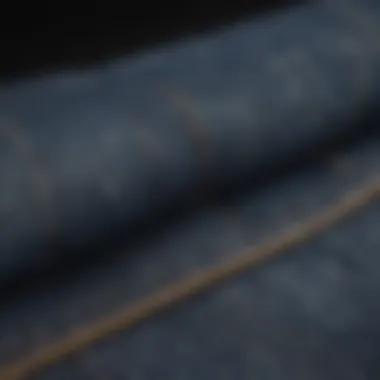Should You Wash Your Jeans? A Comprehensive Exploration


Intro
The question of whether to wash jeans has sparked debate within fashion circles and among everyday wearers. Denim is a durable fabric, often worn for weeks without washing. Yet, some ask if this practice is wise. Understanding how washing affects jeans, and exploring how to maintain denim without frequent washes, can lead to more informed choices for consumers. This article aims to provide a clear perspective on jeans care while considering style and sustainability.
Key Trends
Overview of Current Fashion Trends
In recent years, there has been a notable shift towards sustainable fashion. People are becoming more aware of the environmental footprint of their clothing choices. Denim, often viewed as a staple wardrobe item, aligns perfectly with this trend. The focus is now not only on style but also on the lifespan of garments.
Shoppers increasingly prefer brands that emphasize long-lasting products. Vintage or pre-loved jeans are on the rise. The market sees more second-hand stores and online platforms dedicated to reselling denim.
Popular Care Practices for Denim
Denim enthusiasts are keen to extend the life of their jeans. Some popular practices include:
- Spot cleaning: Addressing specific stains rather than washing the whole pair.
- Freezing: Placing jeans in a sealed bag and storing them in the freezer to kill bacteria.
- Air drying: Hanging jeans to dry enhances fabric longevity and reduces wear.
Sustainable Practices
Understanding Sustainable Fashion
Sustainable fashion incorporates ecological and social principles into the production and consumption of clothing. It encourages mindful purchasing habits and promotes practices that reduce waste. For jeans, this involves methods of sourcing materials, using eco-friendly dyes, and ensuring fair labor practices.
Tips for Sustainable Denim Care
Adopting sustainable practices when caring for denim can significantly reduce your environmental impact. Here are some strategies:
- Limit washing: Only wash jeans when necessary. This helps preserve dye and fabric structure.
- Use cold water: When washing is unavoidable, using cold water reduces energy consumption.
- Choose gentle detergent: Opt for eco-friendly detergents that are less harsh on fabrics.
- Repair over replace: Learn basic sewing skills to repair small tears or frays.
"The best option for jeans care really comes down to how we can blend style with responsibility for our environment."
Prolusion to Denim Care
Denim care has become an important topic for many individuals who wear jeans regularly. Understanding the implications of washing denim is essential for extending the life of these versatile garments. Many people may not realise that how one treats their jeans can have significant effects on both fabric integrity and sustainability. Proper care can lead to better hygiene and can also preserve the aesthetic appeal of the jeans over time.
Consideration of denim care involves a few elements. First, clarity about the composition of denim fabric informs how we should clean it. Second, awareness of the environmental impact associated with traditional washing methods leads to more sustainable decisions. Lastly, consumers need to know the techniques that can help maintain their jeans' appearance without damaging them.
Educating oneself on how to manage denim care is thus fundamental. With the right knowledge and practices, one can enjoy their favorite jeans for many years, all while contributing positively to environmental sustainability.
The Popularity of Jeans
Jeans are often regarded as a wardrobe staple, transcending age and fashion trends. Their adaptability allows for transitions between casual and semi-formal settings. The allure of jeans lies not only in their style but also in the comfort they offer. Most people have several pairs, each catering to different occasions. This widespread popularity contributes to millions of garments being produced every year.
Furthermore, jeans often carry a cultural significance. Many brands create unique stories behind their designs, which resonates with consumers, thus enhancing their desirability. The influence of celebrities and fashion gurus has also played a role in elevating the status of denim in popular culture.
Understanding Denim Fabric
Denim is a robust cotton fabric known for its durability. Its unique weaving method, typically a twill weave, gives denim its signature diagonal ribbing. The density of the fabric affects not just its wear but also how it reacts to washing and care.
Most denim contains a mix of cotton and synthetic fibers. These additions often enhance elasticity and reduce shrinkage, allowing jeans to maintain their shape after multiple wears. Knowledge of the fabric composition is crucial when deciding how often to wash the jeans and which washing methods to use.
In addition, the dyeing process used in denim production can impact color retention. Raw denim, for instance, has a deep color that may fade with washing. Understanding these traits helps consumers make informed decisions about their denim care routines, promoting both longevity and sustainability.
The Case for Washing Jeans
In the discussion surrounding denim care, the idea of washing jeans often emerges as a contentious topic. While some individuals may lean towards minimal washing, the case for washing jeans is built on several compelling factors that merit attention. Regular washing may enhance hygiene, facilitate the removal of stains and odors, and potentially maintain overall fabric quality.


Hygiene Considerations
Hygiene is an essential aspect of clothing care, especially for items worn daily, such as jeans. Denim can accumulate bacteria, skin cells, and sweat over time. This build-up may lead to skin irritations or unpleasant odors if not addressed properly. Washing jeans, therefore, can be seen as a necessity for personal health.
It’s crucial to recognize that washing provides not just cleanliness but also a sense of freshness. The act of laundering removes any hidden germs and ensures that your jeans feel comfortable against the skin. For those living in warmer climates, or engaging in physical activities, this aspect becomes even more relevant.
Additionally, prevention of odor build-up is vital in maintaining the integrity of the denim. Neglecting to wash jeans can lead to persistent smells that are difficult to eliminate completely. An occasional wash can thus help retain a neutral scent and demonstrate an investment in personal hygiene.
Stains and Odor Removal
Another persuasive argument in favor of washing jeans is their susceptibility to stains and odors. Everyday life often presents various opportunities for jeans to become soiled. Food spills, dirt, or makeup can leave marks that may become increasingly difficult to remove if not dealt with promptly.
A thorough wash can effectively eliminate these stains, making jeans look as good as new. There are specific techniques for addressing various types of stains, and knowing when to wash can save a pair of jeans from permanent damage. For instance, treating a grease stain promptly can prevent lasting effects that a simple rinse might not help.
Odors, too, can be effectively managed through washing. Jeans tend to absorb smells from food, smoke, or strong fragrances in the environment. A proper wash can ensure these odors are neutralized rather than lingering.
"Regular washing can remove stains and help maintain the freshness of jeans, keeping them in good condition for longer."
The Argument Against Frequent Washing
The question of whether to wash jeans frequently involves a complex web of considerations. The practice of washing denim too often can negatively impact its durability, appearance, and sustainability. In this section, we will explore two key aspects: how fabric integrity plays a role in maintaining your jeans and the consequences of washing on color and style.
Fabric Integrity and Longevity
Denim is a sturdy material, designed to withstand wear and tear. Frequent washing can lead to fibers breaking down, which may diminish the garment's lifespan. Each wash cycle puts stress on the fabric, potentially causing it to lose its original shape and strength.
To preserve the integrity of your jeans, it is advisable to limit washing. Minimal laundering allows the fibers to maintain their structure, thus prolonging their wearability. Additionally, many denim enthusiasts suggest waiting until jeans are visibly dirty or have an odor before considering washing them. This approach not only conserves energy and water but also respects the craftsmanship that goes into making high-quality denim fabrics.
Color Fading and Distressed Styles
Another critical consideration is color retention. Jeans, especially those treated for a specific wash or distressed appearance, may lose their hue over time. Every wash cycle contributes to color fading, altering the original aesthetic and character of the denim. This fading can be especially pronounced for dark or vibrant colors, leading to an undesirable washed-out look.
Furthermore, many denim wearers appreciate the evolution of their jeans as they age. Wear patterns develop uniquely with time, which creates a personalization that cannot be replicated.
Avoiding unnecessary washes allows the naturally occurring fades and creases to become more pronounced, adding character to the denim.
Conclusion: By understanding the importance of fabric integrity and the implications of frequent washing on color, we can make more informed choices about denim care. Ensuring the longevity and unique style of your jeans is a practice that aligns with both style and sustainability, encouraging responsible ownership.
In summary, consideration of the dangers of frequent washing may contribute to maintaining the quality of denim, with the dual effect of supporting environmentally conscious practices.
Sustainable Practices in Denim Care
Sustainable practices in denim care are not just trends; they are essential for a more responsible approach to fashion. The production of denim has significant environmental implications. By adopting sustainable practices, consumers can enjoy their jeans while minimizing their ecological footprint. This involves understanding the interaction between washing habits, fabric care, and the impact on the environment. Consumers must weigh the benefits of durability, hygiene, and style against the environmental costs of frequent washing.
Environmental Impact of Washing
Washing jeans frequently can lead to water waste and pollution due to the chemicals found in detergents. It is estimated that each wash can consume up to 50 gallons of water. The industrial washing of denim also releases microfibers into waterways, contributing to pollution.
"The fashion industry is one of the largest polluters globally, with denim production playing a significant role."
For example, the production of one pair of jeans can use up to 2,000 gallons of water from growth to manufacturing. Furthermore, the energy used in washing machines adds to greenhouse gas emissions. Reducing washing frequency can significantly mitigate these adverse impacts.
Alternative Cleaning Methods
There are several alternative cleaning methods that can help maintain the condition of jeans while being friendlier to the environment.
Spot Cleaning


Spot cleaning is an effective way to address specific stains without the need for a full wash. This method involves using a damp cloth or sponge along with mild detergent. This approach conserves water and energy, making it a sustainable option.
Spot cleaning is particularly useful for small areas, allowing the rest of the fabric to remain clean. However, it may not remove all odors, especially if the jeans haven't been washed in a long while.
Air Drying
Air drying jeans is a straightforward method that not only protects fabric integrity but also reduces energy consumption. When jeans are dried outdoors or in a well-ventilated space, they maintain their shape better and last longer. This process avoids the harsh effects of the dryer cycle which can degrade fibers over time.
However, air drying can take longer than machine drying and may not always be convenient, particularly in inclement weather.
Freezing
Freezing jeans is another unconventional method for cleaning them. This technique kills bacteria that may cause odor without requiring washing. The key characteristic of freezing is that it avoids the environmental impact of water and detergent use.
Simply place jeans in a plastic bag and leave them in the freezer overnight. While this method is efficient in controlling odor, it does not replace the need for washing, especially when dealing with visible stains.
In summary, sustainable practices in denim care not only help combat the environmental crisis but also preserve the quality of jeans. By considering methods such as spot cleaning, air drying, and freezing, individuals can contribute to a more sustainable wardrobe.
How to Maintain Your Jeans without Frequent Washing
Maintaining jeans without frequent washing is essential for preserving their quality and extending their lifespan. Washing jeans too often can lead to fabric damage, color fading, and the loss of their original shape. By adopting proper care techniques, you can keep your denim looking its best while minimizing environmental impact. This section outlines specific strategies that will help you achieve that balance.
Proper Storage Techniques
Correct storage methods are vital in maintaining the form and cleanliness of jeans. Storing them properly prevents creasing and damage, ensuring they remain in optimal condition until you wear them again. Here are some key points to consider for effective storage:
- Avoid Folding: Instead of folding jeans, consider hanging them. This helps prevent permanent creases and preserves their fit.
- Use Quality Hangers: Select hangers that grip well to prevent slipping. Velvet hangers work best.
- Keep in a Cool, Dry Place: Store jeans away from direct sunlight and moisture, which can cause discoloration and mold.
- Avoid Crowded Spaces: Do not stuff jeans into tight spaces. This will allow air circulation and keep them fresh.
Utilizing these storage techniques ensures that your jeans remain ready to wear, reducing the need for frequent washing.
Routine Airing and Brushing
Incorporating regular airing and brushing into your maintenance routine can significantly enhance the cleanliness of your jeans. These simple practices help to refresh denim fabric without the need for washing. Here are effective methods to implement:
- Airing Outside: On days with good weather, hang your jeans outside for a few hours. This practice removes odor and lets the fabric breathe without water exposure.
- Brushing Off Dirt: Use a soft brush to gently remove surface dirt and lint. Focus on seams and areas prone to collecting dust.
- Spot Cleaning When Needed: For minor stains, use a damp cloth with a small amount of mild detergent. Target only the stained area, ensuring you do not soak the entire fabric.
- Inspect Regularly: Check for any stains or damage frequently. Addressing issues promptly can prevent more extensive cleaning later on.
"Taking care of your jeans does not have to involve frequent washing. Airing and brushing are simple yet effective techniques."
By integrating these methods into your routine, you can maintain your jeans’ appearance and performance without subjecting them to the wear and tear of regular laundering.
Seasonal Considerations for Denim Care
Understanding the impact of the seasons on denim care can significantly enhance the longevity and appearance of your jeans. Each season brings unique challenges and environmental conditions that can affect the fabric's integrity and color. Thus, adapting your care regimen according to seasonal changes is essential.
Summer vs. Winter Care
Summer and winter present distinctly different environments that can influence how you maintain your denim. In the summer, higher temperatures often lead to increased perspiration, which can intensify odors and lead to staining. During this season, it is advisable to focus on lighter cleaning methods such as spot cleaning or airing your jeans outside.
Conversely, winter brings cold, dry air that can strip away moisture from the denim fabric, making it brittle. Wearing jeans consistently in colder climates can create friction and lead to deterioration over time. To combat this, consider gentle washing techniques and ensuring your jeans are stored correctly to maintain their shape and prevent cracking.
Climatic Effects on Fabric
The climate itself has profound effects on denim. High humidity can promote mold growth, particularly if jeans are stored without sufficient ventilation. It is critical during humid months to keep your jeans in a cool, dry place, or even utilize silica packets that absorb moisture.
In colder, dry climates, the lack of humidity can lead the denim to retain static, which can weaken the fibers in the fabric. Applying fabric conditioner can mitigate this effect, providing a balance to the fabric's tension and keeping it soft.
Important Considerations:


- Humidity: Monitor moisture levels when storing jeans in humid conditions.
- Temperature: Take care against extreme heat or cold, which can alter the structure of the fabric.
- Storage Location: Use breathable materials for storage to avoid trapped moisture, which can lead to mildew or fiber deterioration.
"A well-maintained jean collection can last years while maintaining both style and practicality."
By understanding these seasonal dynamics and their effects, you can make well-informed decisions regarding your denim care, ensuring your jeans remain in top condition.
Expert Tips for Washing Jeans when Necessary
When the time comes to wash your jeans, knowing the right approach can make all the difference in maintaining their quality. The tips provided here emphasize importance for preserving the fabric while ensuring cleanliness. Jeans are resilient, but improper care can lead to fading, wearing or shrinking. Understanding these expert recommendations will help you enjoy your jeans for a longer time.
Choosing the Right Detergent
Selecting the appropriate detergent is pivotal for the longevity of denim. Many regular detergents contain harsh chemicals that can break down fibers and strip color from jeans. Look for a detergent specifically designed for dark or colored fabrics. These formulations often lack bleaching agents and are gentler on the fabric. This contributes to color retention while ensuring effective cleaning.
Consider using a biodegradable detergent as well. These types are typically free of harsh additives and are better for the environment, aligning with sustainable washing practices. Their gentler properties help maintain the texture and integrity of your beloved jeans.
Washing Techniques
Washing your jeans thoughtfully can minimize damage while ensuring they stay fresh. Several techniques can enhance the washing process.
Cold Water Washing
Cold water washing is one the best choices for denim. It helps in maintaining fabric integrity while effectively removing dirt and odors without fading colors. The lower temperature reduces the risk of shrinkage that hot water may cause. Moreover, energy consumption is reduced since heating water requires significant resources. This option aligns well with both eco-friendly practices and fabric preservation.
The main advantage of cold water washing is its gentleness on fibers. This method can prolong the life of your jeans, keeping them looking newer for extended periods. However, it may not be effective against very tough stains, so it's important to pre-treat these areas when necessary.
Turn Inside-Out
Turning jeans inside-out before washing is a simple yet effective practice. This method reduces the friction on the outer fabric during the wash cycle, which protects against fading and wear. It also shields any embellishments or distressing from getting damaged or snagged.
By exposing only the inner side to the wash, you lessen the impact on the exterior's color and texture. This technique is particularly beneficial for darker denim shades, helping them maintain their rich hue over time. It is an easy adjustment that leads to significant long-term results.
Using a Gentle Cycle
Choosing a gentle cycle on your washing machine is another valuable tip. The gentle cycle spins slower and involves fewer agitations. This can significantly minimize wear and tear on your jeans, particularly if they have embellishments or fragile areas.
The gentle cycle is suited for lighter fabrics as well, allowing for a soft washing experience. It strikes a critical balance between cleanliness and care. However, be conscious of the setting duration; shorter cycles tend to be beneficial for delicate fabrics such as denim.
"Taking the time to wash jeans thoughtfully not only preserves your investment but also promotes ethical fashion practices."
In summary, these expert tips for washing jeans ensure the longevity and aesthetic value of your favorite pairs. By choosing the right detergent, employing cold water washing, turning your jeans inside-out, and opting for gentle wash settings, you can maintain the quality of your denim with ease.
Ending: Balance in Denim Care
In this exploration of denim care, finding a balance is crucial. The decision to wash jeans is not merely about cleanliness; it encompasses multiple factors such as environmental sustainability, fabric integrity, and personal preference. Each individual's lifestyle, frequency of use, and washing habits can significantly influence how one should approach the laundering of jeans. Understanding these elements can shape one's routine and choices.
Finding Personal Best Practices
Everyone's relationship with denim is unique. Establishing personal best practices for washing your jeans can enhance their longevity while maintaining their appearance. First, assess your lifestyle. If you wear your jeans often in environments prone to staining or odor, consider washing them more frequently, perhaps once every few weeks. On the other hand, for those whose jeans are primarily worn for casual outings, less frequent washing may suffice.
Consider the following tips:
- Choose Quality Products: Select detergents without harsh chemicals to minimize fabric wear.
- Monitor Bacteria Growth: Use air drying techniques to limit bacteria proliferation when washing is not an option.
- Visually Inspect for Stains: Regularly check your jeans for any blemishes that may need immediate attention.
It’s beneficial to listen to your jeans and respond to their needs as they age. By finding a routine that works for you, your denim can remain stylish for an extended period.
Final Thoughts on Denim Maintenance
The maintenance of denim is a nuanced subject, demanding thoughtful consideration. It's essential to strike the right balance between care and neglect. While washing jeans certainly addresses hygiene and freshness, over-washing can diminish their aesthetic appeal and structural integrity. Moreover, adopting sustainable practices can foster a more eco-friendly approach toward personal fashion.
Ultimately, the choice of how often to wash jeans should reflect personal values and lifestyle choices. Embrace a thoughtful assessment of when and how to wash your jeans. Keeping in mind the insights provided, wear your denim with confidence, knowing you are taking steps toward responsible and smart care of your wardrobe.
"Denim maintenance is not just a chore; it is an art of balance and appreciation."
By implementing these practices, each reader can contribute toward a more sustainable and stylish wardrobe. A well-cared-for pair of jeans is not just a garment; it embodies a commitment to quality and longevity in fashion.



